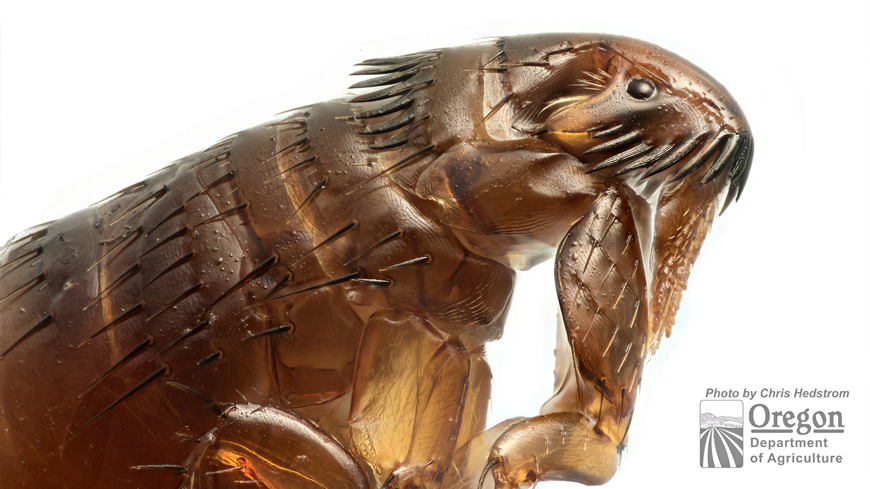Summary
Fleas do have antennae. However, they can’t be seen without magnification. The antennae are located slightly behind the eyes. They’re held in deep grooves (antennal fossae) to protect them from damage.
Details
Location
Fleas have an antenna on both sides of their heads. The antennae are located slightly behind the eyes. They lay recessed in deep grooves called antennal fossae Img 1. The antennae are delicate sense organs, and the fossae protect them from damage when fleas move through host hair. The antennae can be erected from the grooves at will.

Img 1 Flea antennae are held in deep grooves, called antennal fossae, which are located on the sides of a fleas’ head. The antennae themselves aren’t visible in this image.
Appearance & Structure
Flea antennae are short and club-like in appearance. However, they’re too small to be seen with the naked eye. The antennal cuticle is thin, soft, and transparent. It doesn’t visibly tan in most species.
The antennae are comprised of three segments. The bottom (basal) segment is called the scape, the middle segment is called the pedicel, and the top segment is called the club, clava, or flagellum. The flagellum is a flattened, ovoid structure which can be further divided into nine subsegments. Males have longer antennae than females.
Purpose & Function
Sensory Functions
Flea antennae bear sensory structures—mechanoreceptors and chemoreceptors—which can detect touch, smell, heat, humidity, and vibration. They play a significant role in host-finding. Male fleas also locate females by using their antennae to receive hormonal information.
Grasping Females during Mating
The antennae of male fleas are crucial for successful mating. Their inner surface contains disc-shaped clasping organs (copulatory suckers). These organs contain a gland which secretes an adhesive, glue-like substance.
When a male nears a female, he elevates his antennae, moves in beneath her, and clasps his antennae to her abdomen. In some flea species, the antennal attachment lasts the duration of mating. However, with cat fleas, the male retrieves his antennae immediately after their genitals are linked, though they may rise again if he’s disturbed or rejected.
The role of antennae during mating isn’t as important for cat fleas (C. felis) as it is for other fleas species. While male cat fleas do initially grasp females with their antennae, they primarily use their claws to grab onto the female’s legs.




You must log in to post a comment. Log in now.